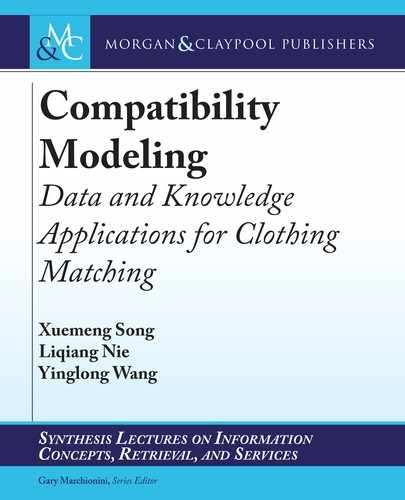
6.4. EXPERIMENT 73
Table 6.2: Performance comparison among different modalities in terms of AUC
Approach AUC
GP-BPR-V 0.8239
GP-BPR-T 0.8313
GP-BPR 0.8388
both GP-BPR-V and GP-BPR-T, which suggests that the visual and contextual signals do com-
plement each other and both contribute to the personalized compatibility modeling. In addition,
similar to above TBPR and VBPR, we found that GP-BPR-T achieves better performance than
GP-BPR-V. is may be due to two reasons: (1) the contextual information of fashion items can
summarize the key features, such as the pattern and material, of fashion items more concisely
and (2) the contextual data usually convey some high-level semantic cues, like the item brand,
which obviously can facilitate not only the personal preference modeling but also the general
compatibility modeling, as items of the same brand are more likely to be compatible.
6.4.3 ON COMPONENT COMPARISON (RQ2)
To gain a better understanding with respect to the contribution of each component in our model,
we introduced two derivatives: G-BPR and P-BPR, where we only consider the general com-
patibility and personal preference modeling component of our model, respectively. Figure 6.4
shows the performance of our model with different component configurations. It can be seen
that our model surpasses the derivative models, confirming the importance of each component in
our model. In addition, interestingly, we noticed that P-BPR achieves better performance than
that of G-BPR, which suggests that the personal preference is the dominant factor affecting the
individual’s personalized clothing matching. To gain more detailed insights, we further checked
the performance of our model with different components on seven popular bottom categories.
As shown in Figure 6.4, GP-BPR outperforms the G-BPR and P-BRP consistently across dif-
ferent bottom categories, which reconfirms the effects of both two components. In addition,
it is interesting to observe that by incorporating the general compatibility modeling, GP-BPR
achieves the greatest improvement over the pure personal preference modeling component P-
BPR in terms of the category “Long Skirt.” One plausible explanation is that long skirts are
usually critical of tops to make compatible outfits. Accordingly, taking the general compatibility
modeling into account can boost the performance of P-BPR significantly. On the contrary, even
with the help of the general compatibility modeling, GP-BPR shows limited superiority over
P-BPR regarding the category “Denim Pants.” at can be attributed to the fact that denim
pants can go with various tops, ranging from coats to T-shirts, which makes incorporating the
general item-item compatibility less helpful.

74 6. PERSONALIZED COMPATIBILITY MODELING
1.0
0.9
0.8
0.7
0.6
0.5
0.4
0.3
0.2
0.1
0.0
All
Long Pants
Denim Pants
Short Pants
Denim Skirt
Skinny Pants
Long Skirt
Pleated Skirt
G-BPR P-BPR GP-BPR
Category
AUC
Figure 6.4: Performance of different methods on different bottom categories. “All” denotes the
whole testing set.
Moreover, we also illustrate the performance of our GP-BPR with respect to the trade-off
parameter in Figure 6.5, where represents the weight of the general compatibility model-
ing component. As we can see, when D 0:3 and P-BPR gets a higher weight than G-BPR,
our GP-BPR achieves the optimal performance, indicating the dominant effect of P-BPR
to GP-BPR. In addition, we noticed that when the value of ranges from 0:8–1:0 and our
GP-BPR degenerates into the G-BPR, there is a sharp performance decrease on GP-BPR.
In a sense, this is consistent with the above observation that the general compatibility modeling
component alone suffers from the poor performance in the context of personalized compatibility
modeling.
0.85
0.80
0.75
0.70
AUC
0.0 0.1 0.2 0.3 0.4 0.5 0.6 0.7 0.8 0.9 1.0
µ
Figure 6.5: Performance of GP-BPR with respect to the trade-off parameter .
..................Content has been hidden....................
You can't read the all page of ebook, please click here login for view all page.
